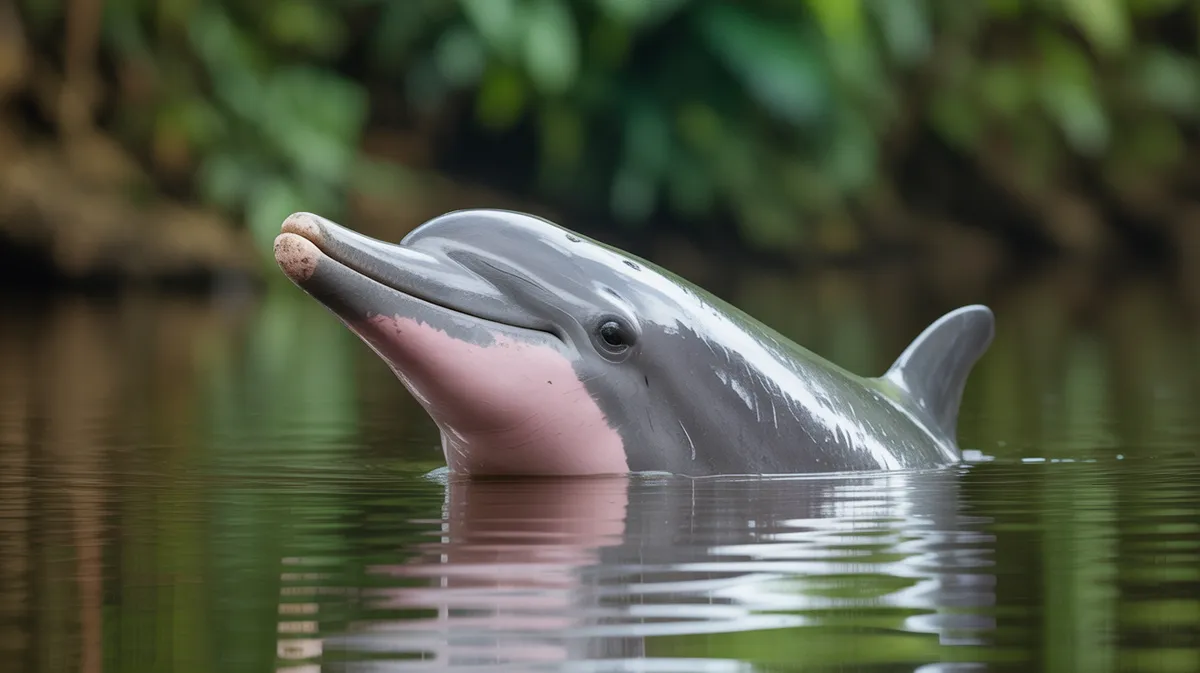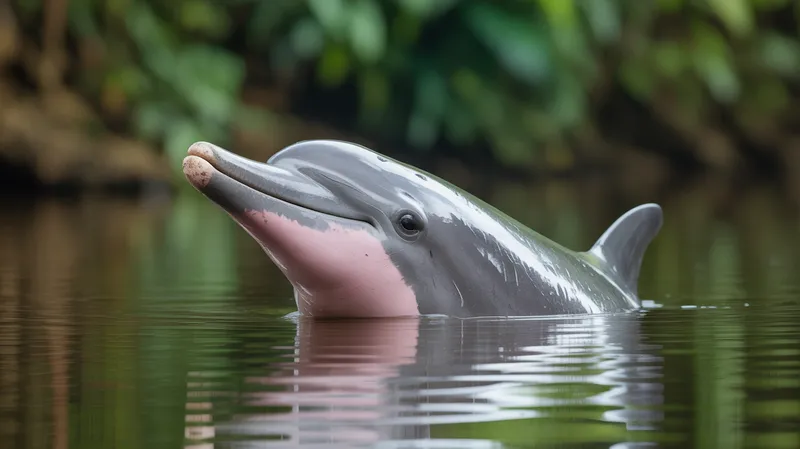
Pink River Dolphin
Inia geoffrensis

Meet the Pink River Dolphin
The Pink River Dolphin, also known as the Amazon River Dolphin or boto, is a freshwater dolphin native to the Amazon and Orinoco river basins in South America. Its most striking feature is its pink coloration, which varies from pale to vivid hues and intensifies with age and activity. Pink River Dolphins are highly intelligent and possess flexible necks that help them maneuver through flooded forests. They are known for their solitary nature, though they may form small groups, especially during the rainy season when rivers flood. These dolphins play a crucial ecological role in their habitat but face threats from habitat destruction and pollution.
Classification
Mammal
Habitat
Amazon and Orinoco river systems
Diet
Carnivore
Lifespan
15-30 years
Conservation
Endangered
Weight
85-185 kg
📖Fascinating Facts
Unique Pink Color
Pink River Dolphins are one of the only dolphin species with a natural pink coloration, which becomes brighter with age and activity.
Adapted to Rivers
They are specially adapted for life in rivers, with flexible necks and large flippers that help them maneuver through flooded forests and tangled roots.
Specialized Diet
Their diet consists of over 50 species of fish, as well as crustaceans and even turtles, making them top predators in their ecosystem.
📋Detailed Description
The Pink River Dolphin (Inia geoffrensis) is the largest species of river dolphin, with adult males reaching lengths of up to 2.5 meters (8.2 feet) and weights of 185 kilograms (408 pounds), while females are generally smaller. Its most distinctive feature is its coloration, which ranges from light gray in juveniles to varying shades of pink in adults; this pinkness is thought to be influenced by age, diet, capillary placement, and even water temperature or excitement. Anatomically, the species is characterized by a long, slender beak filled with 24–34 conical and molar-like teeth per jaw, specialized for grasping and crushing a diverse array of prey. The Pink River Dolphin has a flexible neck due to unfused cervical vertebrae, allowing it to maneuver adeptly among submerged roots and branches in flooded forests. Its dorsal fin is low and ridge-like, and its flippers are large and paddle-shaped, providing excellent maneuverability in complex aquatic environments. The eyes are small but functional, adapted for the turbid river waters, and echolocation is highly developed, enabling precise navigation and prey detection. Socially, Pink River Dolphins are typically solitary or found in small groups of 2–4, but larger aggregations may occur in areas of abundant food or during the flood season. Their vocal repertoire is complex, including clicks, whistles, and pulsed calls, used for communication and echolocation. The species is long-lived, with lifespans estimated at over 30 years in the wild.
💡 Did you know?
Unlike oceanic dolphins, Pink River Dolphins can move between water levels in flooded forests, swimming among trees during the rainy season.
🔬Research & Sources
Wikipedia Summary
The Amazon river dolphin, also known as the boto, bufeo or pink river dolphin, is a species of toothed whale endemic to South America and is classified in the family Iniidae. Three subspecies are currently recognized: I. g. geoffrensis, I. g. boliviensis and I. g. humboldtiana. The position of the Araguaian river dolphin within the clade is still unclear. The three subspecies are distributed in the Amazon basin, the upper Madeira River in Bolivia, and the Orinoco basin, respectively.
Last Modified: 6/2/2025
🎭Behavior & Social Structure
Pink River Dolphins are generally solitary but may form loose associations, especially during the rainy season when rivers flood and fish become more abundant. Their daily activity patterns are crepuscular, with increased foraging at dawn and dusk. They are opportunistic feeders, preying on over 50 species of fish, including catfish, tetras, and piranhas, as well as crustaceans and occasionally freshwater turtles. Hunting involves sophisticated echolocation to locate prey in murky waters, often using their long beaks to probe into riverbed sediment or submerged vegetation. They are known to exhibit playful behaviors, such as tossing sticks or interacting with floating objects, and have been observed engaging in cooperative feeding and even interspecific interactions with other river dolphins. Social interactions are complex, involving tactile contact, vocalizations, and occasional displays of aggression, particularly among males during the breeding season.
👶Reproduction & Life Cycle
Breeding in Pink River Dolphins is seasonal, typically coinciding with the onset of the flood season (November to June), when food is most plentiful. Courtship behaviors include tactile stimulation, vocalizations, and displays such as leaping or presenting objects. Mating is promiscuous, with both sexes having multiple partners. The gestation period lasts approximately 11–15 months, after which a single calf is born, measuring about 80 centimeters (31 inches) in length and weighing around 12 kilograms (26 pounds). Calving peaks during the low water season (July to September), possibly to take advantage of receding waters and concentrated prey. Mothers nurse their calves for up to a year, with weaning occurring gradually as the calf learns to hunt. Parental care is primarily maternal, with calves remaining close to their mothers for protection and learning.
🛡️Adaptations & Survival
Pink River Dolphins have evolved several unique adaptations for life in dynamic freshwater environments. Their flexible necks, due to unfused cervical vertebrae, allow them to turn their heads up to 90 degrees, aiding navigation through dense submerged forests. The large, paddle-shaped flippers and low dorsal fin enhance maneuverability in shallow, obstacle-filled waters. Their echolocation system is highly refined, compensating for poor visibility in turbid rivers. The molar-like teeth enable them to crush hard-shelled prey, such as crustaceans and turtles. Their skin is thick and vascularized, which may help with thermoregulation and healing from injuries. The pink coloration, more pronounced in males, may serve as a form of sexual selection or camouflage among the dappled light of flooded forests.
📚Research Sources
🎨Cultural Significance
The Pink River Dolphin holds a prominent place in Amazonian folklore and indigenous mythology, often depicted as a shape-shifter or enchanted being. Legends tell of the boto transforming into a handsome man at night to seduce women, a story used to explain unexpected pregnancies. In some cultures, harming a dolphin is considered bad luck or taboo. The species is also a symbol of the Amazon's biodiversity and is featured in local festivals, art, and ecotourism initiatives. However, traditional beliefs have not always translated into effective protection, and in some areas, dolphins are still hunted or persecuted.
🔬Recent Research & Discoveries
Recent research has focused on population genetics, revealing significant genetic differentiation among subspecies and isolated populations, which has implications for conservation management. Ongoing studies using acoustic monitoring and satellite telemetry are improving understanding of movement patterns, habitat use, and responses to environmental changes. Mercury contamination studies have highlighted the health risks to both dolphins and local human populations. There is active debate regarding the taxonomic status of the Araguaian river dolphin (Inia araguaiaensis), with some evidence suggesting it may be a distinct species. Conservation projects increasingly involve community-based monitoring and education to reduce human-dolphin conflict and promote sustainable fisheries.
🎥Wildlife Videos

Pink Dolphins? | Weird Nature
About National Geographic: National Geographic is the world's premium destination for science, exploration, and adventure.
National Geographic

Facts: The Pink River Dolphin (Amazon River Dolphin)
Quick facts about this playful and curious pink freshwater dolphin that lives in South America! The Amazon river dolphin (pink river ...
Deep Marine Scenes

Pink River Dolphins Of The Amazon Rainforest's Hunting Secret | Earth's Great Rivers | BBC Earth
Earth's Great Rivers Embark on the ultimate river voyage down three of the world's most epic rivers – the Amazon, the Nile and the ...
BBC Earth

Discovering the Amazon River Dolphin: Nature's Pink Wonder
Dive into the enchanting world of the Amazon River Dolphin, also known as the pink river dolphin! In this captivating video, we ...
World Wonders

The Enigmatic Pink Dolphin: A Journey to Amazonia
The Enigmatic Pink Dolphin: A Journey to Amazonia** Join us on an unforgettable expedition into the heart of the **Amazon ...
Landmarks

Amazon River Dolphins: Pink Freshwater Dolphins That Eat Piranhas
----------- SOCIAL MEDIA https://www.tiktok.com/@animalogic https://www.instagram.com/animalogicshow/ ...
Animalogic
🌍Habitat Information
The Pink River Dolphin typically inhabits Amazon and Orinoco river systems environments. Pink River Dolphins have adapted to their environments with specialized features and behaviors.
Primary Habitat:
Amazon and Orinoco river systems
More detailed habitat information will be available soon.
🛡️Conservation Status
The Pink River Dolphin is currently classified as Endangered. Conservation efforts are crucial for preserving this species for future generations.
Common Threats:
- 🏠Habitat loss and fragmentation
- 🌡️Climate change impacts
- 🎯Hunting and poaching
- 🏭Human-wildlife conflict
⚠️Threats & Conservation Challenges
Major threats to Pink River Dolphins include habitat degradation from deforestation, dam construction, and waterway modification, which fragment populations and reduce access to critical floodplain habitats. Pollution from mercury (due to gold mining), agricultural runoff, and industrial waste accumulates in their tissues and affects health and reproduction. Incidental capture in fishing gear (bycatch), deliberate killing for use as bait in catfish fisheries, and competition with humans for fish resources further impact populations. Climate change, leading to altered flood regimes and water temperatures, poses an emerging threat. Current population trends are declining, with the species listed as Endangered by the IUCN, and local extinctions have been reported in some river systems.
🔬Scientific Classification
Scientific Name
Inia geoffrensis
Classification Hierarchy
🔍 About Taxonomic Classification
Taxonomic classification is a hierarchical system used by scientists to classify and organize living organisms based on shared characteristics and evolutionary relationships.
The system moves from broad categories (Kingdom) to increasingly specific ones, with each animal's scientific name typically consisting of its Genus and species.
📝Community Notes
Share your observations and insights about the Pink River Dolphin with our community of wildlife enthusiasts.
Join Our Community
Sign in to share your observations and connect with fellow wildlife enthusiasts.
Sign In to ContributeNo community notes yet
Be the first to share your observations about the Pink River Dolphin!
Explore Pink River Dolphin
Select a tab above to learn more about this amazing animal.
📸Photo Gallery
No photos available for this animal yet.
🌟Discover More Wildlife
Continue your journey of discovery with more fascinating animals from our database
